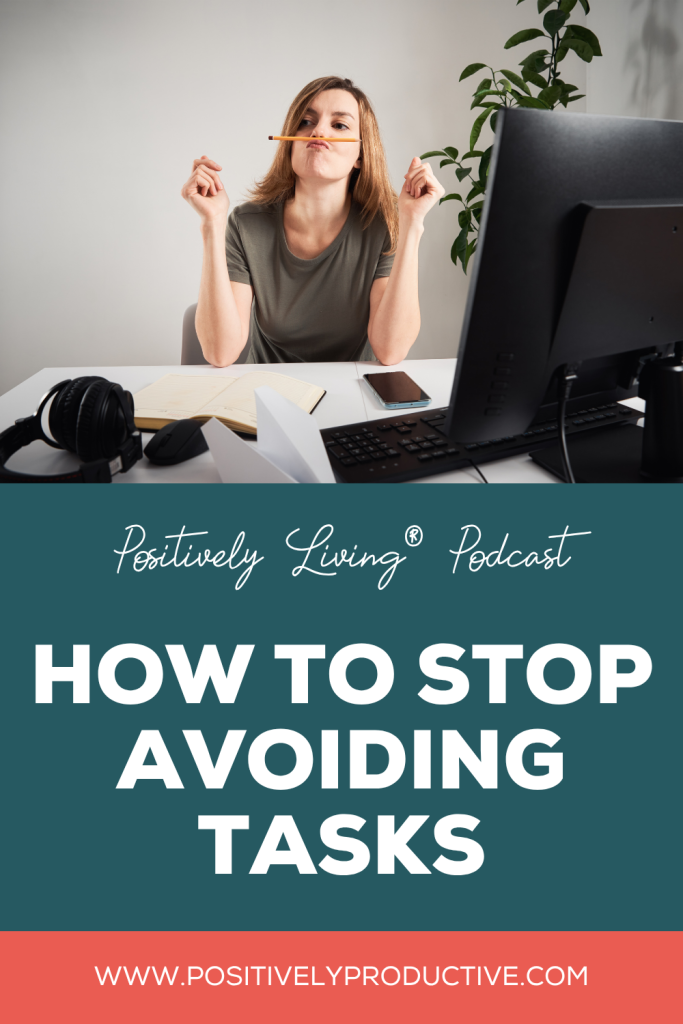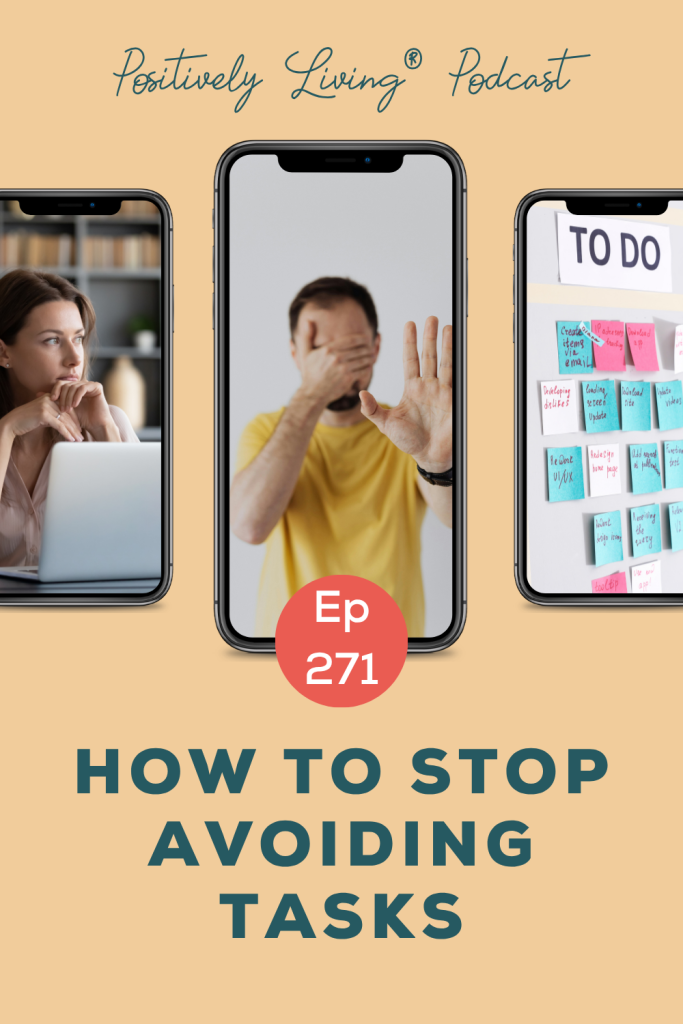Do you find yourself constantly putting off tasks, searching for distractions instead of focusing on what needs to be done? We all experience procrastination, and it’s not a personal flaw. It often comes from a lack of motivation, clarity, or energy, not a lack of desire or work ethic.
This week, in episode 271 of the Positively LivingⓇ Podcast, I explore why we avoid tasks and, more importantly, how to get yourself to forge ahead. Learn practical strategies to bypass resistance and start taking action on your goals.
I cover the following topics:
- How procrastination stems from factors like perfectionism, task aversion, or decision fatigue, not laziness.
- Focusing on starting tasks, even using the two-minute rule for quick wins, to build momentum.
- Using short sprints with timers to tackle bigger projects, making the work less daunting.
- Proactively eliminating or deferring distractions like phone notifications and cluttered environments.
- Rewarding yourself after completing tasks to create positive associations and boost motivation.
- The option to start with a fun activity as a strategic bridge to energize yourself before less appealing tasks.
Ready to stop avoiding and start doing? Pick one strategy to try today and see how easily you can begin.
Stop Dodging Tasks: Simple Ways to Get Things Done (Even the Boring Ones!)
Ever find yourself staring at your to-do list, feeling a giant wall of “nope” blocking your way? You know you should do that task, but suddenly, cleaning the entire house seems like a better idea. Or maybe your phone just magically appears in your hand, pulling you into an endless scroll. We all do it! Task avoidance, or procrastination, is a universal experience, and it is not because you are lazy or flawed. It is often your brain trying to protect you from things it sees as boring, difficult, or even scary. But what if you could learn how to gently guide your brain past that resistance and start tackling those tasks with more ease?
This article is for anyone who struggles with getting started, feels overwhelmed by their to-do list, or simply wants smarter ways to outsmart procrastination. We will look at common reasons why we avoid tasks and, more importantly, give you five clear, actionable strategies to move forward. Get ready to bypass the dread, build momentum, and actually get things done.
Why We Avoid Tasks: It’s Not About Being Lazy
Before we dive into solutions, let us get one thing straight: if you procrastinate, you are not lazy. Procrastination usually comes from a lack of things like motivation, clear understanding, or energy—not a poor work ethic or a lack of desire to achieve. Your brain is wired to seek pleasure and avoid pain (and boring tasks count as “pain” to your brain!). This means it will quickly look for distractions when faced with something difficult or unappealing.
Here are seven common reasons why we put things off:
- Perfectionism: The fear of not doing it perfectly, or of criticism, can stop you before you even begin.
- Self-Sabotage: Sometimes, you might avoid a task because, deep down, you worry that finishing it will lead to something you do not want.
- Future You Problem: When you are tired or overwhelmed, it is easy to dump tasks on your future self, not thinking about the impact.
- Task Aversion: Your brain just does not like boring, hard, or scary stuff. It wants fun!
- Decision Fatigue: Too many choices can wear out your brain. When you are exhausted from decisions, doing nothing feels like the easiest answer.
- Lack of Energy: You need good energy for challenging tasks. If you are tired, your brain will convince you that it is impossible.
- Unclear Goals: If you do not know exactly where you are going, your brain sees no reason to start the trip. This leads to jumbled ideas and feeling overwhelmed.
Understanding these reasons is the first step to finding the right solution. You are not broken; you just need different tools!
5 Powerful Ways to Stop Avoiding Tasks
Now that we understand why your brain resists, let us look at simple, effective ways to trick it into action. These strategies will help you build momentum and bypass that initial dread.
1. Focus Only on Starting (The Two-Minute Rule)
One of the biggest blockers to getting things done is looking at the entire task and feeling overwhelmed by its size. You think about the finish line, not the first step. This makes the whole thing feel daunting, so you never even begin.
The trick is to shift your focus entirely to just starting. Forget about finishing. Just aim to begin. A fantastic tool for this is the Two-Minute Rule. This rule says: If an action takes two minutes or less to do, do it right now. No delays, no overthinking. It is perfect for small chores that often pile up. For example, washing your plate right after you eat, opening and sorting mail as soon as it arrives, or quickly responding to a simple email. The goal is to build the habit of immediate action for small tasks. Even tiny completions give you a mental boost and create positive energy that can carry over to bigger things. Think about picking up clothes from “the chair” for two minutes a day; it can stop that mountain from growing into a weekend-long cleanup!
Quick Wins & Key Takeaways:
- Shift your goal from “finishing” to “starting” a task.
- Use the Two-Minute Rule: if it takes 2 minutes or less, do it now.
- Examples: wash a dish, sort mail, reply to a quick email.
- Gain mental momentum and positive energy from small wins.
- Build consistent habits by making actions super doable.
2. Go Fast: Use Sprints and Gamify Your Work
When a task feels big or boring, your brain will put up resistance. You overthink it, dread it, and then avoid it. How can you bypass that dread and dive into action without fully committing to the whole thing?
The answer is sprinting. This means you give yourself permission to work on a task for a very short, set amount of time, with full permission to stop when the timer goes off. It is not about finishing the task, but about doing a portion of it. Set a timer for 10-20 minutes, focus intensely, and then take a break. You might be surprised how much you get done, or you might even want to keep going! The key is to gain your brain’s trust: it knows it only has to work for a limited time. This works great for kids with task aversion too; make it a race or a challenge to see how much they can clean in 10 minutes. This idea of making work a game, called gamifying, is highly effective because our brains love fun and challenges. You can even create a music playlist with upbeat songs to match your sprint’s energy and pace.
Quick Wins & Key Takeaways:
- Use a time limit to tackle a small part of a bigger project.
- Set a timer (10-20 minutes is a good start) and commit to stopping when it rings.
- Gamify tasks by making them a race or a challenge.
- Use an energizing music playlist to boost your focus and pace during sprints.
- Gain your brain’s trust by sticking to the time limit.
3. Clear Your Space: Delete or Defer Distractions
When you are trying to focus, distractions are everywhere, lurking around every corner. They are like villains, waiting to pull you away from important (but often boring) tasks. And let’s be honest, sometimes you even look for them when you really want to avoid a task, like endlessly scrolling your phone. These distractions, whether they are phone pings, emails, or even a cluttered workspace, constantly pull your attention and break your focus.
The key here is to proactively eliminate or at least delay these distractions. Think about what typically pulls you away. For technology, put your phone on “do not disturb” or, better yet, put it in another room. Close unnecessary computer tabs, especially social media or news sites. You can even use website blockers for set periods. Remember, you are not missing out; you are pausing to focus. You can still check everything later, making your information consumption intentional. For your physical space, keep your workspace clean and free from visual clutter. If noise is an issue, try noise-canceling headphones or focus-enhancing music. Also, communicate with others: let friends and family know when you need uninterrupted time. If thoughts distract you (like new ideas popping up), keep a notepad handy to jot them down quickly and get them out of your mind for later.
Quick Wins & Key Takeaways:
- Put your phone on “do not disturb” or in another room during focus time.
- Close unnecessary tabs and consider website blockers.
- Clean your workspace to reduce visual clutter.
- Use noise-canceling headphones or focus music if your environment is noisy.
- Communicate with others about your need for uninterrupted time.
- Keep a notepad nearby to capture distracting thoughts or new ideas.
4. Reward Yourself: Fuel Your Motivation
We often fall into the trap of thinking that simply finishing a task is its own reward. While there is satisfaction in checking something off a list, it is often not enough to truly motivate us, especially for challenging or boring tasks. If you only rely on the feeling of accomplishment, your brain might not see enough reason to push through the initial resistance.
To truly build and maintain habits, you need to be intentional about rewarding yourself. This is different from the reward of the task itself (like a clean kitchen). It is a reward for you. Think of a small sweet treat, a few minutes of intentional scrolling, or some time to just chill. Your reward does not have to be expensive or take a lot of time. The goal is to create a positive association with doing the thing you want to avoid. This personal reward gives your brain the extra motivation it needs to push through the resistance and helps you repeat the desired action in the future.
Quick Wins & Key Takeaways:
- Distinguish between the task’s outcome (e.g., a clean desk) and your personal reward.
- Be intentional about what your personal reward will be.
- Choose small, non-expensive rewards like a treat or short break.
- Create a positive association with completing boring or difficult tasks.
- Use rewards to build motivation and reinforce desired habits.
5. Have Fun First: Create a Bridge to Productivity
This might sound backward, but for many people, especially those with task aversion or unique energy patterns, starting with something fun can be a powerful strategy. The mistake is thinking you must tackle the hardest thing first when you are feeling low on motivation or energy. This often leads to more resistance and procrastination.
Instead, use a short, fun activity as a bridge to productivity. This is not procrastination; it is a strategic energy management tool. Engage in something genuinely enjoyable for a set, short time before diving into your main task. This boosts your happiness, shifts your mindset, and gives you the energy surge you need to tackle that less appealing work. Imagine an artist who sketches for 10 minutes before starting their main job; it taps into their creative flow and builds momentum. Make sure your fun activity is short, impactful, and truly energizing for you. Set a timer, just like with sprints, and commit to transitioning to your main task once the fun is over. This way, the fun becomes a positive cue, not another form of avoidance.
Quick Wins & Key Takeaways:
- Use a short, fun activity as a “bridge” to harder tasks.
- Choose something genuinely energizing for you (e.g., upbeat music, quick stretch, creative play).
- Set a strict time limit for the fun activity to prevent avoidance.
- Use this technique to boost mood, shift mindset, and generate momentum.
- Make the fun a strategic cue for starting your main work.
Move Past Procrastination and Start Doing
Procrastination is a common human response, not a personal flaw. It often comes from your brain trying to protect you from what it perceives as boring or difficult. By understanding these underlying reasons, you can choose smart strategies to push past that resistance and get things done.
Here is your quick recap and action plan:
- Focus on Starting: Use the Two-Minute Rule to build momentum with small tasks.
- Sprint for a Bit: Tackle bigger tasks in short, focused bursts with a timer.
- Clear Distractions: Proactively remove anything that pulls your attention away from your work.
- Reward Yourself: Give yourself a small, personal reward after completing challenging tasks to build motivation.
- Have Fun First: Use a short, energizing activity as a bridge to tackle less appealing work.
Pick just one of these ideas that resonates most with you and try it today. What is the first step you will take to stop avoiding tasks and start taking action?











